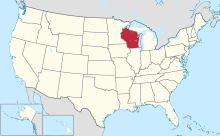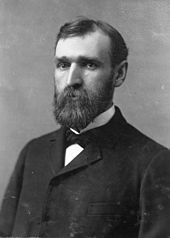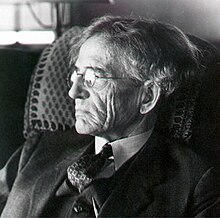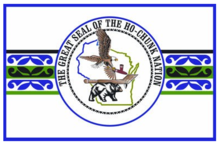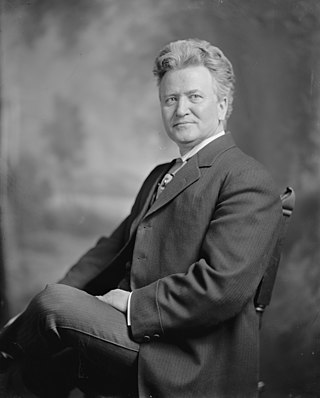
Robert Marion "Fighting Bob" La Follette Sr., was an American lawyer and politician. He represented Wisconsin in both chambers of Congress and served as the governor of Wisconsin from 1901 to 1906. A Republican for most of his life, he ran for president of the United States as the nominee of his own Progressive Party in the 1924 presidential election. Historian John D. Buenker describes La Follette as "the most celebrated figure in Wisconsin history".

The Progressive is a left-leaning American magazine and website covering politics and culture. Founded in 1909 by U.S. senator Robert M. La Follette Sr. and co-edited with his wife Belle Case La Follette, it was originally called La Follette's Weekly and then La Follette's. In 1929, it was recapitalized and had its name changed to The Progressive. For a period, The Progressive was co-owned by the La Follette family and William Evjue's newspaper The Capital Times. Its headquarters is in Madison, Wisconsin.

Robert Marion La Follette Jr. was an American politician who served as United States senator from Wisconsin from 1925 to 1947. A member of the La Follette family, he was often referred to by the nickname "Young Bob" to distinguish him from his father, Robert M. "Fighting Bob" La Follette, who had served as a U.S. senator and governor of Wisconsin. Robert Jr., along with his brother Philip La Follette, carried on their father's legacy of progressive politics and founded the Wisconsin Progressive Party. Robert Jr. was the last major progressive party politician in the U.S. Senate, ending in 1946 when the party disbanded. La Follette was defeated in the 1946 Republican Senate primary by Joseph McCarthy.

The Progressive Era (1896–1917) was a period of widespread social activism and political reform across the United States focused on defeating corruption, monopoly, waste, and inefficiency. The main themes ended during American involvement in World War I (1917–1918) while the waste and efficiency elements continued into the 1920s. Progressives sought to address the problems caused by rapid industrialization, urbanization, immigration, and political corruption; and by the enormous concentration of industrial ownership in monopolies. They were alarmed by the spread of slums, poverty, and the exploitation of labor. Multiple overlapping progressive movements fought perceived social, political and economic ills by advancing democracy, scientific methods, professionalism and efficiency; regulating businesses, protecting the natural environment, and improving working conditions in factories and living conditions of the urban poor. Spreading the message of reform through mass-circulation newspapers and magazines by "probing the dark corners of American life" were investigative journalists known as "muckrakers". The main advocates of progressivism were often middle-class social reformers.
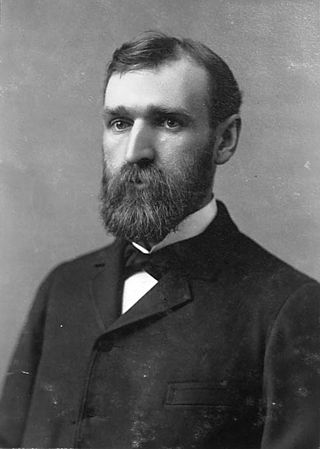
Charles Richard Van Hise was an American geologist, academic and progressive. He served as president of the University of Wisconsin (UW) in Madison, Wisconsin, from 1903 to 1918.

Isabelle Case La Follette was a women's suffrage, peace, and civil rights activist in Wisconsin, United States. She worked with the Woman's Peace Party during World War I. At the time of her death in 1931, The New York Times called her "probably the least known yet most influential of all American women who have had to do with public affairs in this country." She was the wife and helpmate of Robert "Fighting Bob" La Follette—a prominent Progressive Republican politician both in Wisconsin and on the national scene—and as co-editor with her husband of La Follette's Weekly Magazine.
The history of Wisconsin encompasses the story not only of the people who have lived in Wisconsin since it became a state of the U.S., but also that of the Native American tribes who made their homeland in Wisconsin, the French and British colonists who were the first Europeans to live there, and the American settlers who lived in Wisconsin when it was a territory.
The University of Wisconsin–Extension (UW–Extension) was the outreach arm of the University of Wisconsin System. It provided statewide access to university system's resources and research to Wisconsin residents of all ages. Fulfilling the promise of the Wisconsin Idea, UW–Extension extended the boundaries of the university to the boundaries of the state through its four divisions of Cooperative Extension, Continuing and Online Education, Business and Entrepreneurship, and Public Broadcasting. It was created as a division of UW–Madison in 1907, and took its new form in 1965 as an autonomous unit. The abolition of UW-Extension as a separate entity was begun July 1, 2018.

Bascom Hill is the iconic main quadrangle that forms the historic core of the University of Wisconsin–Madison campus. It is located on the opposite end of State Street from the Wisconsin State Capitol, and is named after John Bascom, former president of the University of Wisconsin.
The Progressive Party was a political party created as a vehicle for Robert M. La Follette, Sr. to run for president in the 1924 election. It did not run candidates for other offices, and it disappeared after the election. The party advocated progressive positions such as government ownership of railroads and electric utilities, cheap credit for farmers, the outlawing of child labor, stronger laws to help labor unions, more protection of civil liberties, an end to American imperialism in Latin America, and a referendum before any president could lead the nation into war.
Arthur Peabody was the campus architect for the University of Wisconsin from 1905 to 1915 and the state architect of Wisconsin from 1915 to 1938.
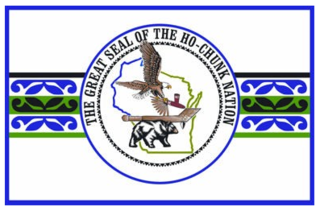
The Ho-Chunk Nation is a federally recognized tribe of the Ho-Chunk with traditional territory across five states in the United States: Wisconsin, Illinois, Iowa, Minnesota, and Missouri. The other federally recognized tribe of Ho-Chunk people is the Winnebago Tribe of Nebraska. The tribe separated when its members were forcibly relocated first to an eastern part of Iowa known as the Neutral Ground, then to Minnesota, South Dakota and later to the current reservation in Nebraska.

The University of Wisconsin School of Medicine and Public Health (UWSMPH) is a professional school for the study of medicine and public health at the University of Wisconsin–Madison. It is one of only two medical schools in Wisconsin, along with the Medical College of Wisconsin in Milwaukee, and the only public one.
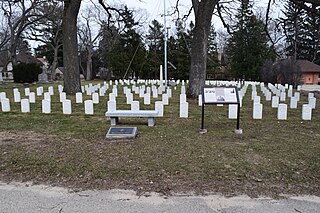
Forest Hill Cemetery is located in Madison, Wisconsin, and was one of the first U.S. National Cemeteries established in Wisconsin.

North Hall was the University of Wisconsin's first building. Built in 1851 in the woods and brush that would become Bascom Hill, this one building was the UW for its first four years, housing both dorm rooms and lecture halls. John Muir resided in North Hall when he was a student at the university from 1860 to 1863.

The University of Wisconsin–Madison is a public land-grant research university in Madison, Wisconsin. Founded when Wisconsin achieved statehood in 1848, UW–Madison is the official state university of Wisconsin and the flagship campus of the University of Wisconsin System. It was the first public university established in Wisconsin and remains the oldest and largest public university in the state. UW–Madison became a land-grant institution in 1866. The 933-acre (378 ha) main campus, located on the shores of Lake Mendota, includes four National Historic Landmarks. The university also owns and operates the 1,200-acre (486 ha) University of Wisconsin–Madison Arboretum, located 4 miles (6.4 km) south of the main campus, which is also a National Historic Landmark.
The Wisconsin Idea Theatre was essentially a cultural program, developed at the University of Wisconsin c. 1943. It was headed by Robert E. Gard within the College of Agriculture, with a mission for developing theatre arts throughout the state. Gard worked with anyone that had an idea, to develop radio dramas, or stage performances. He worked with 4-H, seeking to develop children's theatre within the state, as well as encouraging and assisting faith groups to develop dramas based on their faith.
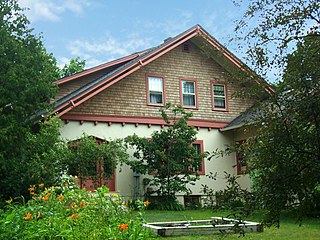
The John and Nell Commons House is a large hilltop bungalow built in 1913 in Madison, Wisconsin, from which UW professor John R. Commons wrote influential books on economics, helped craft Progressive public policy, and mentored a generation of economists. The house itself was designed by Cora Tuttle - not a formally trained architect, but the first woman to practice architecture in Madison. In 1985 the house was added to the National Register of Historic Places.

The Richard T. Ely House is a Georgian Revival-style house built in 1896 in Madison, Wisconsin - designed by Charles Sumner Frost for Richard T. Ely, a prominent economics professor. In 1974 it was added to the National Register of Historic Places. It is located within the University Heights Historic District.
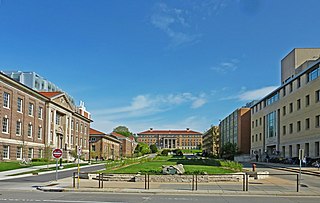
The Henry Mall Historic District is a landscaped mall and the surrounding academic agriculture buildings on the University of Wisconsin–Madison campus, roughly laid out by architects Warren Laird and Paul Cret from 1906 to 1908, with buildings constructed from 1903 to 1961. In 1992 the district was added to the National Register of Historic Places.
